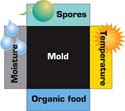To achieve long-term success as a professional roofing contractor, you have to focus on two fundamental business principles: performing quality work and making money. But performing quality work alone won't ensure success, especially in today's ultra-competitive business environment where consumers' expectations for quality and service are at an all-time high.
In addition to focusing on quality, the degree to which your company is successful—and profitable—can be determined by how effective it is at one essential business component—marketing. This especially is true in the roofing industry where it is not uncommon for roof system purchasers to view all roofing contractors as being basically the same.
NRCA efforts
NRCA receives thousands of calls and hundreds of thousands of visits to its Web site each year from consumers looking for roofing information and professional roofing contractors. The association provides consumers with numerous information sources to assist them in identifying and fulfilling their roofing needs.
When consumers are equipped with knowledge, they know roofing work should not be viewed as a commodity purchase and realize they "get what they pay for." In addition, it is much more likely they will be satisfied with their roof systems and roofing contractors. Armed with knowledge, consumers rarely select fly-by-night contractors and substandard materials.
In 2003, NRCA's newly developed strategic plan showed members want assistance with marketing efforts and believe NRCA should continue to promote professionalism in the roofing industry. As a result, NRCA's leadership decided it was time to conduct research, examine marketing practices of leading roofing contracting companies and publish new information to assist roofing contractors with their marketing efforts.
The research
NRCA contracted with Right Angle Marketing, an independent, Dallas-based marketing consulting company, to conduct research and produce an updated NRCA marketing publication. NRCA's staff, Contractor Management Committee members and Residential/Steep Contractor Management Committee members reviewed the research's parameters and identified roofing contracting companies throughout the United States that are well-known for having effective marketing programs. These contractors were asked to participate in in-depth telephone interviews and provide sample materials to assist the development of the final publication.
The publication's goal is to assist roofing contractors in effectively establishing themselves in their markets and provide ideas to improve their marketing efforts. It also is designed to be practical, apply specifically to the roofing industry and include real-world examples.
Participant findings
This article cannot address all the information contained in Marketing for Professional Roofing Contractors, NRCA's new marketing publication; however, it will cover many of its main ideas.
Some interesting information is revealed in the publication. For example, participants named community service, sales presentations and brochures as their most commonly used marketing techniques, but the most effective marketing tools named included public-relations activities, effective sales force and providing good customer service.
When asked to focus on a key differentiator to describe how their companies differ from competitors, contractors named such things as quality, stability, integrity, experience, safety, roofing material knowledge and community presence. Most contractors also reported using a tagline or marketing slogan to describe their key differentiators and reinforce them in prospects' minds. Examples include, "Leading with quality, value and craftsmanship"; "Providing peace of mind"; and "Family owned and quality assured since 1952."
Participants reported relying heavily on word-of-mouth referrals to generate new business; however, most do not use formalized incentive programs to drive referrals. Instead, most surveyed contractors believe prompt responses to customers' requests, proactive communication and quality craftsmanship are enough to gain referrals.
Participants were somewhat split about the role manufacturers play in contractors' marketing initiatives.
Manufacturers increasingly are providing marketing collateral materials and templates to help contractors with their marketing efforts, and many participants reported using them effectively. Some expressed concern with manufacturers selling directly to building owners and their representatives because doing so may limit contractors' abilities to differentiate themselves in consumers' minds. Others find manufacturers' preferred contractor lists limit competition to those contractors qualified to install a particular roof system.
As manufacturers become more involved with marketing, especially directly to building owners and homeowners, it will become increasingly important for contractors to monitor the effects and find new ways to differentiate themselves.
Marketing plan
Based on the research conducted, NRCA's marketing publication provides detailed information about how you can assess your current operations and marketing strategy to develop a useful marketing plan.
This involves conducting market research to evaluate your marketing strategy, identifying your target market(s), understanding peaks and declines in your business, and identifying your company's strengths and weaknesses.
Market research should include primary research, which involves collecting data directly from research subjects, and secondary research, which involves collecting data from pre-existing sources, such as the Internet, industry associations and primary research conducted by others.
Your research should include an internal environment analysis, which involves evaluating your company's mission and vision, age, size, project and marketing history, and financial goals. In addition, it should include an external environment analysis, which includes evaluating your customers; competition; and political, economic, social and technological factors. The publication shows you how to incorporate a strengths, weaknesses, opportunities and threats (SWOT) analysis to bring together your internal and external environments and evaluate your company.
Your final marketing plan should incorporate your situation and SWOT analyses; establish measurable marketing objectives, strategies and tactics; and include an implementation plan. Selecting the most appropriate way to market your company will depend on many factors—the most important aspects to consider include your targeted customers, geographic market and marketing budget.
Public relations
For roofing contractors, public-relations efforts often are an overlooked part of marketing. Basically, public relations is the process of shaping how your company is perceived by others. The purpose of public relations is to create a company identity, build name recognition and communicate your marketing message. It includes working with the media and anything that creates an impression of your company, such as how your telephones are answered, your vehicles' condition and your employees' attitudes when communicating with customers.
Public-relations activities involve a proactive attempt to help you build credibility in your market, such as self-promotion, speaking opportunities, using employees as advocates, writing articles, sending press releases and making media pitches. Public-relations efforts can be dynamic and require a time commitment, but they also can be extremely simple and inexpensive. Remember—most roofing contractors are not well-versed in public relations, so even a basic program can yield positive results and set your company apart from the others in your market.
Collateral materials
Some of the most common, basic marketing tools for roofing contractors are collateral materials, such as brochures, newsletters and proposals. These materials can be produced inexpensively and distributed to a wide range of customers and prospect groups.
NRCA's publication provides numerous tips for producing collateral materials—the main issue to remember is that their quality, appearance and content should reflect your company's image and will influence your customers' and potential customers' perceptions about your company's quality and workmanship.
When developing collateral materials, consider their intended purpose, audience, budget, length of use and distribution. Make sure the design and style are appropriate for your intended audience, and include contact information and any other information useful to your audience. Do not include too much detailed information—the goal is to generate interest, not necessarily close the deal.
Advertising
Advertising can be an expensive marketing plan component, but most marketing plans include some form of advertising. Advertising can be used as a branding tool or way to generate leads. NRCA's publication provides detailed information about how to select and purchase the various kinds of advertising available.
When developing your advertising plan, consider the goals for your advertising campaign and find potential advertising options that match your needs for geography, target audience, timing, availability and cost.
Web Site
A quality Web site often is overlooked or underappreciated by roofing contractors. But your Web site provides 24-hour access to all types of audiences, and those visiting your Web site are seeking information about your company. When developing your site, remember it should be structured to provide easy access to the information your target audience seeks. Most people visit a Web site only once if it is not helpful. You also may want to consider providing an online newsletter to drive traffic to your site. Focus on educational topics that link to articles or information on your Web site.
Closing
NRCA's new marketing publication, Marketing for Professional Roofing Contractors, is a useful guide for roofing contractors whether they already have marketing plans or are just getting started. Because marketing can mean the difference between thriving and merely surviving, it is important for you to re-examine your company's marketing plan.
In an industry with so much competition that fights hard not to have roofing work be perceived as a commodity, the roofing contractors who, in addition to performing quality work, implement effective ways to differentiate their companies will succeed in the long run.
Carl Good is publisher of Professional Roofing and NRCA's associate executive director of communications and membership development.
Editor's note: Marketing for Professional Roofing Contractors will be available in April for $75 for NRCA members and $105 for nonmembers. Contact NRCA InfoExpress at (866) ASK-NRCA (275-6722) for additional information.


